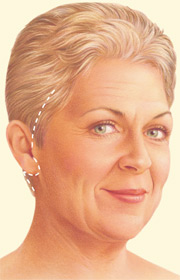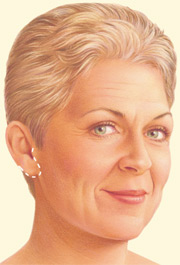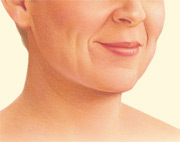The loss of youthful contours in the face can be due to a variety of factors, including heredity, gravity, environmental conditions, and stress. A facelift, or rhytidectomy, is a surgical procedure that improves visible signs of aging in the face and neck, such as:
- Sagging in the middle of your face
- Deep creases below the lower eyelids
- Deep creases along the nose extending to the corner of the mouth
- Fat that has fallen or has disappeared
- Loss of skin tone in the lower face that creates jowls
- Loose skin and excess fatty deposits under the chin and jaw can give even a person of normal weight the appearance of a double chin
Rejuvenation procedures typically performed in conjunction with a facelift are brow lift, to correct a sagging or deeply furrowed brow, and eyelid surgery to rejuvenate aging eyes.
More Information:
What facelifts won’t do:
As a restorative surgery, a facelift does not change your fundamental appearance and cannot stop the aging process.
Is it right for me?
A facelift can only be performed surgically; non-surgical rejuvenation treatments cannot achieve the same results, but may help delay the time at which a facelift becomes appropriate and complement the results of surgery. Facelift surgery is a highly individualized procedure and you should do it for yourself, not to fulfill someone else’s desires to to try to fit any sort of ideal image. Facelift surgery is a good option for you if:
- You are physically healthy
- You do not smoke
- You have a positive outlook and specific, but realistic goals in mind for the improvement of your appearance
Facelifts at a glance
Rhytidectomy surgery was one of the top surgical cosmetic procedures performed in 2009. 133,320 people had facelift surgery in 2013.
| Age | |
| 13-19 | 0% |
| 20-39 | 2% |
| 40-55+ | 98% |
| Gender | |
| Males | 9% |
| Females | 91% |
.jpg)
- Why you want the surgery, your expectations and desired outcome
- Medical conditions, drug allergies and medical treatments
- Use of current medications, vitamins, herbal supplements, alcohol, tobacco and drugs
- Previous surgeries
Your surgeon may also:
- Evaluate your general health status and any pre-existing health conditions or risk factors
- Discuss the options available to you for facelift and facial rejuvenation
- Examine and measure your face
- Take photographs for your medical record
- Discuss your options and recommend a course of treatment
- Discuss likely outcomes of a facelift and any risks or potential complications
- Discuss the type of anesthesia that will be used
Prior to surgery, you may be asked to:
- Get lab testing or a medical evaluation
- Take certain medications or adjust your current medications
- Stop smoking well in advance of surgery
- Avoid taking aspirin, anti-inflammatory drugs and herbal supplements as they can increase bleeding
Special instructions you receive will cover:
- What to do on the night before and morning of surgery
- The use of anesthesia during your face lift
- Post-operative care and follow-up
Your plastic surgeon will also discuss where your procedure will be performed. A facelift may be performed in an accredited office-based surgical center, outpatient or ambulatory surgical center, or a hospital.
You’ll need help
If your facelift is performed on an outpatient basis, be sure to arrange for someone to drive you to and from surgery and to stay with you for at least the first night following surgery.
What happens during facelift surgery?
Step 1 – Anesthesia
Medications are administered for your comfort during a facelift procedure. The choices include intravenous sedation and general anesthesia. Your doctor will recommend the best choice for you. A variety of other procedures can further enhance the outcome of a facelift. They include:
- Facial implants or fat transfer
- Soft tissue augmentation to recontour the facial structure
- Resurfacing techniques to improve the tone and texture of facial skin
- Wrinkle reduction by injection of fat or fillers
Step 2 – The incision
Depending on the degree of change you’d like to see, your rhytidectomy surgery choices include a traditional facelift, limited incision facelift or a neck lift. A traditional facelift incision often begins in the hairline at the temples, continues around the ear and ends in the lower scalp. Fat may be sculpted or redistributed from the face, jowls and neck. Underlying tissue is repositioned, commonly the deeper layers of the face and the muscles are also lifted. Skin is redraped over the uplifted contours and excess skin is trimmed away. A second incision under the chin may be necessary to further improve an aging neck. Sutures or skin adhesives close the incisions.
Traditional Facelift


An alternative to a traditional facelift uses shorter incisions at the temples, continuing around the ear and possibly within the lower eyelids or under the upper lip. Limited Incision


Sagging jowls, loose neck skin and fat accumulation under the chin may be corrected with a neck lift. The neck lift incision often begins in front of the ear lobe and wraps around behind the ear ending in the lower scalp.
Neck Lift

Step 3 – Closing the incisions
Once healed, the incision lines from a facelift are well concealed within the hairline and in the natural contours of the face and ear.
Step 4 – See the results
The visible improvements of a facelift appear as swelling and bruising subside. Your final result should not only restore a more youthful and rested appearance, but also help you feel more confident about yourself.
Facelift risks include:
- Anesthesia risks
- Bleeding
- Infection
- Poor wound healing and skin loss
- Facial nerve injury with weakness
- Temporary or permanent hair loss at the incisions
- Fluid accumulation
- Numbness or other changes in skin sensation
- Persistent pain
- Unfavorable scarring
- Prolonged swelling
- Skin irregularities and discoloration
- Sutures may spontaneously surface through the skin, become visible or produce irritation that require removal
- Unsatisfactory results may include: asymmetry, unsatisfactory surgical scar location and unacceptable visible deformities at the ends of the incisions. (It may be necessary to perform an additional surgery to improve your results)
- Deep vein thrombosis, cardiac and pulmonary complications
Be sure to ask questions: It’s very important to ask your plastic surgeon questions about your facelift procedure. It’s natural to feel some anxiety, whether it’s excitement for your anticipated new look or a bit of preoperative stress. Don’t be shy about discussing these feelings with your plastic surgeon.
A special note about the use of fibrin sealants (tissue glue)
Fibrin sealants (made from heat-treated human blood components to inactivate virus transmission) are used to hold tissue layers together at surgery and to diminish post-operative bruising following surgery. This product has been carefully produced from screened donor blood plasma for hepatitis, syphilis, and human immunodeficiency virus (HIV). These products have been used safely for many years as sealants in cardiovascular and general surgery. This product is thought to be of help in diminishing surgical bleeding and by adhering layers of tissue together.
When you go home
If you experience shortness of breath, chest pains, or unusual heart beats, seek medical attention immediately. Should any of these complications occur, you may require hospitalization and additional treatment. The practice of medicine and surgery is not an exact science. Although good results are expected, there is no guarantee. In some situations, it may not be possible to achieve optimal results with a single surgical procedure. Another surgery may be necessary.
Be careful
Following your physician’s instructions is key to the success of your surgery. It is important that the surgical incisions are not subjected to excessive force, abrasion, or motion during the time of healing. Avoid wearing any clothing that must go over your head. Your doctor will give you specific instructions on how to care for yourself.

When your procedure is completed, a bandage could gently be placed around your face to minimize post facelift swelling and bruising. A thin tube may be present to drain any excess blood or fluid that may collect under the skin.
You will be given specific instructions that may include: how to care for the surgical site, medications to apply or take orally to aid healing and reduce the potential for infection, specific concerns to look for at the surgical site or in overall health, and when to follow up with your plastic surgeon.
Be sure to ask your plastic surgeon specific questions about what you can expect during your individual recovery period.
- Where will I be taken after my surgery is complete?
- What medication will I be given or prescribed after surgery?
- Will I have dressings/bandages after surgery? When will they be removed?
- Are stitches removed? When?
- When can I resume normal activity and exercise?
- When do I return for follow-up care?
It may take a few months for swelling to fully dissipate and for incision lines to mature. Life-long sun protection and a healthy lifestyle will help extend the results of your rejuvenated, more youthful appearance. As swelling and bruising subside, the visible improvements of a facelift appear. Your final result should not only provide a more youthful and rested appearance, but also help you feel more confident about yourself. Although good results are expected from your procedure, there is no guarantee. In some situations, it may not be possible to achieve optimal results with a single surgical procedure and another surgery may be necessary.

Prices for facelifts can vary. A surgeon’s cost may be based on his or her experience, the type of procedure used, and geographic office location. Many plastic surgeons offer patient financing plans, so be sure to ask. The cost of facelift surgery may include:
- Surgeon’s fee
- Hospital or surgical facility costs
- Anesthesia fees
- Prescriptions for medication
- Post-surgery garments
- Medical tests
Your satisfaction involves more than a fee
When choosing a plastic surgeon for a facelift, remember that the surgeon’s experience and your comfort with him or her are just as important as the final cost of the surgery.
Most health insurance does not cover cosmetic surgery or its complications.
- General anesthesia: Drugs and/or gases used during an operation to relieve pain and alter consciousness.
- Hematoma: Blood pooling beneath the skin.
- Intravenous sedation: Sedatives administered by injection into a vein to help you relax.
- Tear trough: Deep creases below the lower eyelids.
- Nasolabial fold: Deep creases between the nose and cheek
- Jowls: A jaw line that sags into the neck, usually caused by loss of muscle tone in the lower face.
- Local anesthesia: A drug injected directly to the site of an incision during an operation to relieve pain.
- Rhytidectomy: A surgical procedure also known as facelift, to reduce sagging of the mid-face, jowls and neck.
Use this checklist of facelift questions during your consultation.
- Are you certified by the American Board of Plastic Surgery?
- Were you specifically trained in the field of plastic surgery?
- How many years of plastic surgery training have you had?
- Do you have hospital privileges to perform this procedure? If so, at which hospitals?
- Is the office-based surgical facility accredited by a nationally- or state-recognized accrediting agency, or is it state-licensed or Medicare-certified?
- Am I a good candidate for this procedure?
- What will be expected of me to get the best results?
- Where and how will you perform my procedure?
- What surgical technique is recommended for me?
- How long of a recovery period can I expect, and what kind of help will I need during my recovery?
- What are the risks and complications associated with a facelift?
- How are complications handled?
- How can I expect my face to look over time?
- What are my options if I am dissatisfied with the cosmetic outcome of my facelift?
- Do you have before-and-after photos I can look at for this procedure and what results are reasonable for me
- Graduate from an accredited medical school
- Complete at least six years of surgical training following medical school with a minimum of three years of plastic surgery residency training
- Pass comprehensive oral and written exams
- Be certified by the ABPS or in Canada by The Royal College of Physicians and Surgeons of Canada®
- Complete continuing medical education, including patient safety each year
- Perform surgery in accredited, state-licensed, or Medicare-certified surgical facilities
Look for the ASPS Member Surgeon logo.

.jpg)


 3510 N. Ridge Rd, Suite 100
3510 N. Ridge Rd, Suite 100